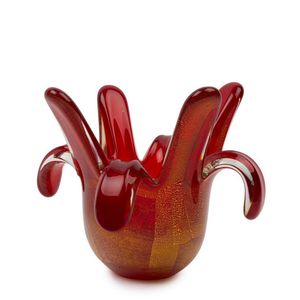Red Aventurine Sea Anemone Vase by Seguso
Seguso, red cased Murano glass vase in the form a sea anemone with aventurine gold inclusions, circa 1950's, 20 cm high, 26 cm wide
You must be a subscriber, and be logged in to view price and dealer details.
Subscribe Now to view actual auction price for this item
When you subscribe, you have the option of setting the currency in which to display prices to $Au, $US, $NZ or Stg.
This item has been sold, and the description, image and price are for reference purposes only.
- Aventurine Glass - Aventurine glass is a type of glass where small flakes of gold, copper, or silver color form in the glass and provide a glitter or sparkle to the glass when seen in the light. The small flakes are created by adding copper, gold or silver to the molten glass during the glassmaking process.
- Circa - A Latin term meaning 'about', often used in the antique trade to give an approximate date for the piece, usually considered to be five years on either side of the circa year. Thus, circa 1900 means the piece was made about 1900, probably between 1895 and 1905. The expression is sometimes abbreviated to c.1900.
- Inclusions - Inclusions in glass objects refer to small, often irregularly shaped particles or bubbles that are trapped within the glass during the manufacturing process. These inclusions can be intentional or unintentional, and can range in size, shape, and composition.
Intentional inclusions are often added to the glass for decorative purposes, and can include materials such as colored glass, metallic foils, or even small mementos like photographs or other objects. These intentional inclusions are typically added to the glass while it is still in a molten or semi-molten state and are then moulded or blown into the final shape of the object.
Unintentional inclusions, on the other hand, are typically the result of impurities or air bubbles that become trapped within the glass during the manufacturing process. These inclusions can be seen as small specks or bubbles within the glass, and can sometimes be a sign of poor quality control during production.
While intentional inclusions can be a desirable feature of some glass objects, unintentional inclusions can sometimes be seen as a defect, and can reduce the value of a piece. However, in some cases, certain types of unintentional inclusions can actually increase the value of a piece, such as with antique glass that contains bubbles or other imperfections that are characteristic of the time period in which it was made.
This item has been included into following indexes:
- glass, types or items - aventurine 79
- Seguso family (Italy) - Venetian / Murano glass, makers 132
- Venetian / Murano glass, housewares
Visually similar items

John Campbell pottery mug, 10 cm high. yellow/green
Sold by
in
for
You can display prices in $Au, $US, $NZ or Stg.

A 19th century Bohemian etched glass tankard
Sold by
in
for
You can display prices in $Au, $US, $NZ or Stg.

Amethyst Carnival glass water jug, 'Peacock on the Fence', 23 cm high
Sold by
in
for
You can display prices in $Au, $US, $NZ or Stg.

Richard Shields carved nephrite sculpture of a Maori stylised shark, multiple curved and tapering fins, raised on an ovoid platform base, good medium dark tone. Length 17.5 cm
Sold by
in
for
You can display prices in $Au, $US, $NZ or Stg.
